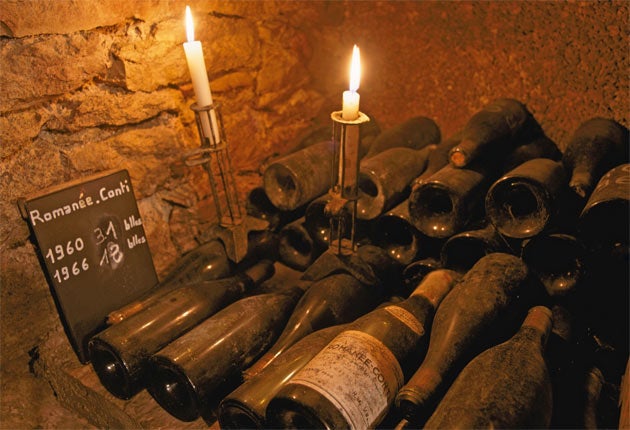The most expensive wine in the world is about to go on sale
A case of 12 bottles of 1988 vintage Romanée-Conti, which goes on sale at an auction in Geneva this Sunday, is estimated to be worth around £140,000

A treasure trove of hundreds of bottles of the most expensive wine in the world, Romanée Conti, will go under the auctioneer’s hammer in Geneva this Sunday.
Usually, the mythical red burgundy is sold in twos and threes or – at most – cases of 12. On Sunday, a private collection of more than 1,400 bottles of burgundies from the Romanée Conti Domain – including hundreds of bottles from the minuscule Romanée Conti vineyard itself – will be sold by a new Geneva auction house called Baghera Wines.
The entire collection is estimated to be worth at least £2.7m. The most valuable single lot is expected to be a case of 12 bottles of 1988 vintage Romanée-Conti, which is estimated to be worth around £140,000.
That works out at £11,666 a bottle or £2,333 for a small glass.
It is debatable, however, whether any of the wine on sale this Sunday, including hundreds of bottles from other Grand Cru Burgundy vineyards, will ever be drunk. Investment, or speculation, in trophy wines, notably by Asian buyers, means that the world’s most prized names like Romanée-Conti are more often kept in vaults or secure warehouses than in wine cellars.
The collection on sale this Sunday is said to have been assembled over 15 years by a Swiss investor. It has been stocked until now at the Geneva Freeport, a warehouse complex exempt from customs duties and taxes often used to store valuable works of art.
Executive director Michael Ganne, who founded Baghera Wines last year with two former Christie’s colleagues, Julie Carpentier and Emmanuel Mercé, said the sale was “ the most significant auction of exceptional wines of the last two decades in continental Europe”.
Such an auction will add to the mystique surrounding Romanée-Conti and other grand cru Burgundy wines but will not necessarily please Burgundian wine producers. Romanée-Conti and other big names in Burgundy have been trying in recent years to control the speculation by selling their wine only to wealthy wine drinkers and traders who promise not to sell to speculators or “investors”.
Why is Romanée-Conti so prized, first by wine experts and then by investors?
Roald Dahl wrote in his book My Uncle Oswald: “Sense for me this perfume! Breathe this bouquet! Taste it! Drink it! But never try to describe it! Impossible to give an account of such a delicacy with words! To drink Romanée-Conti is equivalent to experiencing an orgasm at once in the mouth and in the nose.”
Romanée-Conti is grown from Pinot Noir grapes in a tiny vineyard about the size of one and a half football pitches close to the village of Vosne-Romanée, north of Beaune and south of Dijon. This plot of land produces only about 6,000 bottles a year – small even for the patchwork of 1,000 mostly tiny vineyards which make up the Côte d'Or in central Burgundy.
It is this scarcity as much as supreme quality which has created the mystique and value of Romanée-Conti.
The source of the quality is more complicated to define. In 2011, The Independent was granted a rare interview with Aubert de Villaine, joint proprietor of the wider Romanée-Conti domaine, whose family has owned the Romanée-Conti vienyard for seven generations.
He said that the jagged shapes of the Burgundy vineyards were established by monks at least 600 years ago. “Over many centuries, these seemingly random boundaries between vineyards were worked out and then engraved in marble by our ancestors,” Mr Villaine said. “They realised that, by doing so, they could capture something unique and wonderful.”
By trial and error – and large and attentive consumption over many years – the monks discovered that wines from closely adjoining plots could have different qualities and tastes. Without knowing it, they had discovered the concept of “terroirs” – the almost mystical French belief that tiny changes in sub-soil and micro-clime can produce vast differences in the quality of wine.
Subscribe to Independent Premium to bookmark this article
Want to bookmark your favourite articles and stories to read or reference later? Start your Independent Premium subscription today.

Join our commenting forum
Join thought-provoking conversations, follow other Independent readers and see their replies